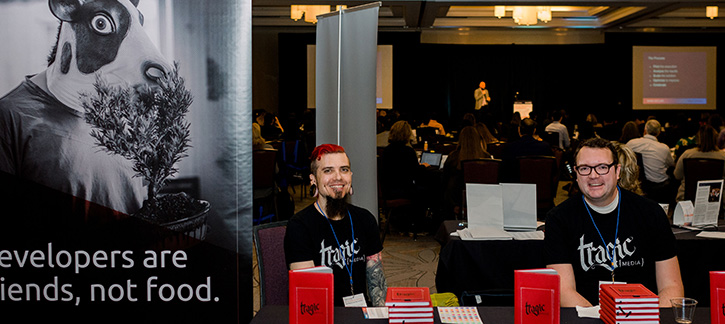With each passing year, consumers spend more time on mobile devices. The user experiences and expectations that are formed as consumers also translates to business software.
Having great marketing, product, and customer support experiences on mobile are no longer optional. You need to ask yourself: What are you doing to create a successful and scalable mobile marketing strategy? How are you preparing for the next 2-3 years?
Tragic Media is the technology partner for the San Diego chapter of the American Marketing Association (SDAMA). In this role, we support the organization with all of its digital needs, from design and software development to cloud hosting. The Tragic team manages the technical needs of sdama.org and created a custom WordPress theme for the Art of Marketing event.
We often support internal marketing teams at large organizations, like the AMA. Sometimes these teams have misunderstood perceptions about developers due to bad previous experiences. This fact inspired our campaign for the event: Developers are friends, not food.
Our CEO Rich Rudzinski was asked to speak on a mobile marketing panel moderated by Mary Barnett and joined by Ron Weber and Adam Fox.
Below you will find Rich's thoughts that were shared at the 2019 Art of Marketing Conference hosted by SDAMA. We are bullish on the future of mobile marketing and personalization!
Mobile Marketing Trends
As we discussed on the panel, there are several exciting mobile marketing trends coming this year, including artificial intelligence (AI), augmented reality (AR), voice, and progressive web apps (PWAs). With that being said, we believe that the single largest trend is personalization.
Personalization is the overarching theme, which leads product teams to consider specific technology. Today, the concept of personalization goes so much further than adding your {customer_name} tag in your email blasts. (This is fine, but no longer enough!)
We now have sophisticated software and detailed analytics that enable you to tailor your messaging, notifications, and even site content based on the customer’s demographic and previous interactions.
A local San Diego startup gaining a lot of traction, SendLane, is a perfect example of this new trend. Their software-as-a-service platform allows marketers to send tailored email sequences (also called drip campaigns) based on customer interactions, including page visits, content engagement, and purchases.
Mobile User Experience (UX)
Looking forward, the mobile experience is becoming even more rich and vibrant. As phone sizes continue to grow (have you seen these new foldable phones?!), your website and application should be optimized for every display.
Mobile traffic is still a large driver for most businesses, but there are more screen sizes and resolutions than ever before. You should be considering a wide array of device types from the traditional smartphone and tablet to smart TVs, internet of things (IoT) devices, cars (Apple CarPlay and Android Auto), and more.
Accessibility is also a hot topic this year as more people – of all ages – continue to move online. Your brand experience should be accessible via voice readers and screen readers, as well as meeting the necessary contrast ratios to ensure visibility for more users.
To learn more about accessibility, check out our article: The Growing Importance of Accessibility
The differences are night and day, regardless of whether you are building a B2C mobile app or a B2B web application. People want fewer, more memorable interactions with brands.
Personalization, The Right Way
Personalization is a major trend that is reshaping mobile marketing. When surveyed, 61% of millennials are "happy to share personal data if it leads to a more personalized" shopping experience (source).
Every single day, your customers are overloaded with more and more digital noise. In order to be successful, it's crucial to create well-crafted marketing campaigns that are tailored based on user preference and past interactions.
Marketing efforts that are thoughtful, contextual, and personal from the ground up will outperform mass emails and alerts.
For instance, 53% of respondents shared they would be "interested in price drops for products" they previously browsed in the past" and 34% said personalization "would be [a] major motivator in interacting further with a retailer" (source).
The differences are night and day, regardless of whether you are building a B2C mobile app or a B2B web application. People want fewer, more memorable interactions with brands.
Conclusion
Marketing has a frantic pace of change. With the rise of affordable software and an explosion of data, digital marketers have the ability to craft campaigns that impress customers.
In 2019, we believe that AI, AR, and other frontier technology will lead to new customer experiences. At the core, though, companies are turning to these tools for a very specific reason: personalization.
Marketing campaigns should bring customers closer to products and services, all while building brand loyalty.
Subscribe to our newsletter to get additional content about software, marketing, and UX trends!
Need the right technology to elevate your digital marketing? Contact Tragic Media today for a free consultation!

